On July 20th, 1969, President Nixon made a historic call to the Apollo XI astronauts during their lunar walk, marking a significant moment in human history and highlighting the possibilities of communication technologies. We are looking again at the challenge of maintaining users in deep space connected to mission operations, their loved ones, and with anyone on Earth.
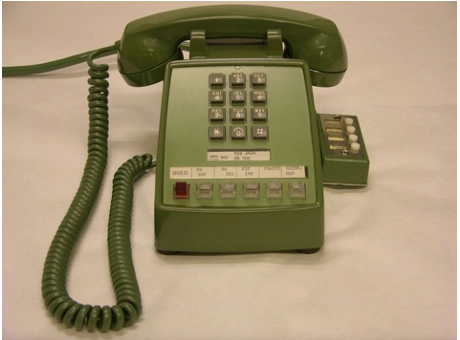
The telephone network is the largest real-time communications network available on Earth, with more than 6 billion mobile and fixed users connected to make and receive calls, send messages and more.
At SPATIAM, we developed a Telephony Delay Tolerant Network System to enable users of the Telephone network to communicate via Delay and Disruption Tolerant Networking with remote users in deep space.
This system aims to connect embedded devices, smartphones, and other users of the telephone network seamlessly with DTN network users at interplanetary distances. The application leverages both terrestrial and space technologies to adapt to the delay and disruption of space, while providing an adaptive user experience.
Communication is simple and follows the same principles as telephone communication on Earth. To start a conversation, users simply send a message or make a call to a phone number from their device. If the receiver is outside of the normal range of communication, the system will notify users when their message is expected to arrive and may provide an outline of the path it will take. On the other end of the network, the system facilitates a communicator for remote, non-telephony nodes, supporting communications via audio, video, text, and files.
The Blueprint
The system architecture is straightforward, when you communicate from the telephone network with a remote “DTN” telephone user (identified with an E.164 telephone number), the message is routed through our Telephone Network to DTN Connector. This intermediate application node routes your data through DTN to the final receiver. On the way, there can be several hops, all outlined by the DTN network's contact plan managed by Spatiam's DTN Network Platform.
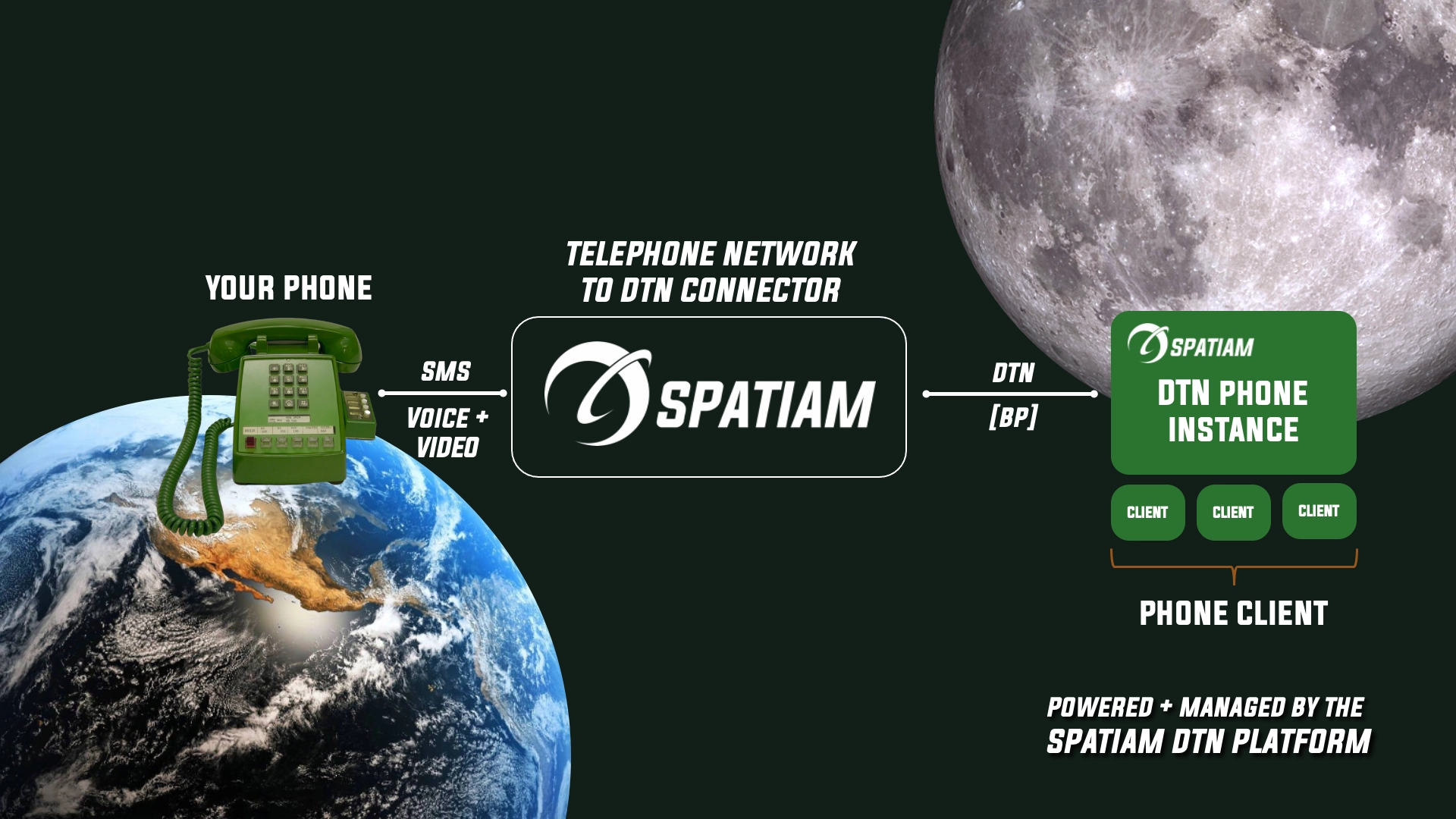
Avocado Phone
Avocado Phone is the name of our prototype in which the first experiments were executed. With Avocado Phone, we simulated a DTN network between the Earth and the moon to connect to the telephone network as shown in the figure below.
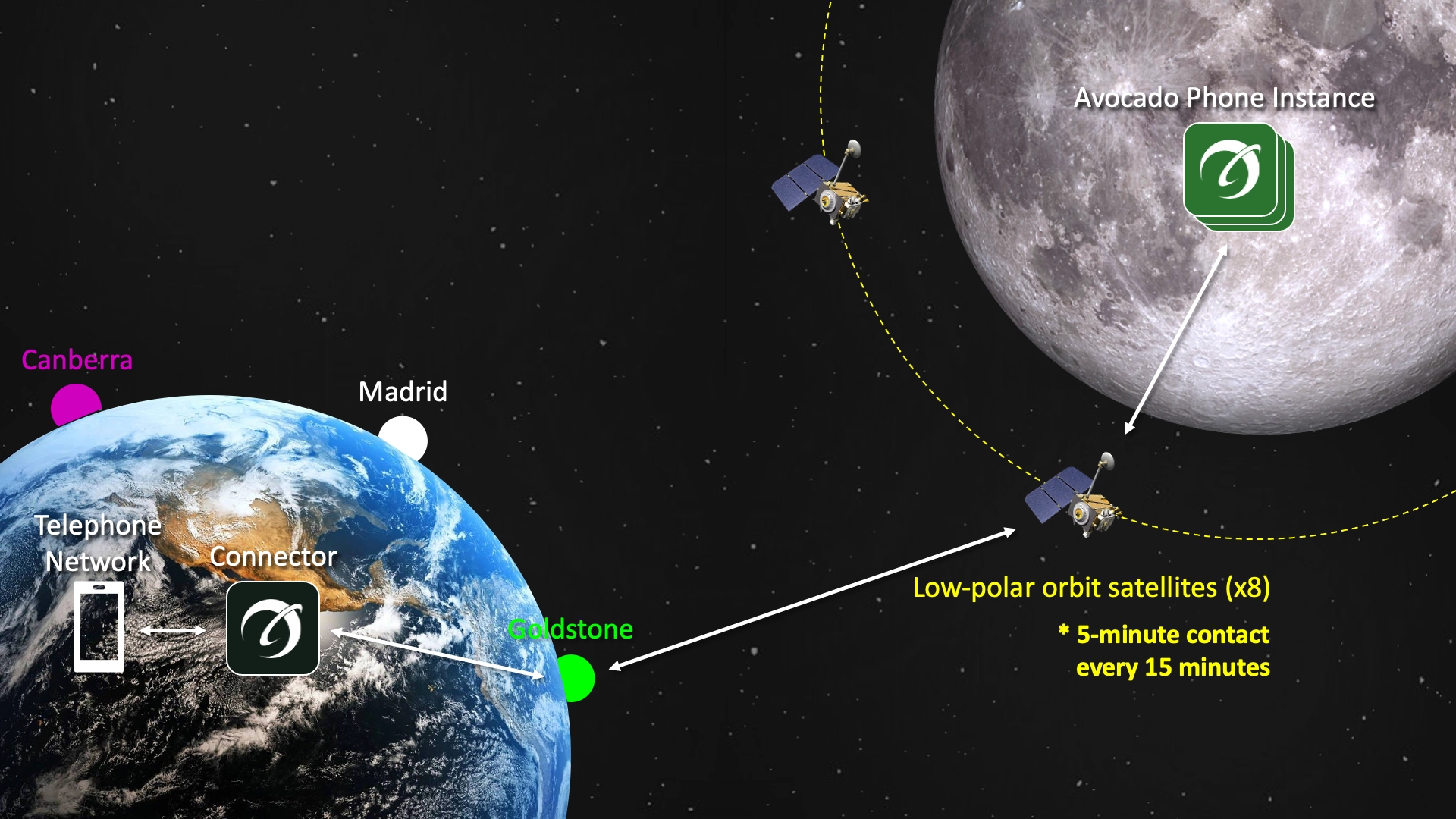
Avocado Phone - Prototypical network scenario for telephone communication to the moon.
The simulated network consisted of the Spatiam Telephony Connector, that communicated with 3 simulated nodes corresponding to the 3 stations of the Deep Space Network (DSN) operated by NASA. In the Moon's orbit we simulated 8 low-polar orbit satellites, meaning that each satellite is always in view from at least one of the DSN stations. The setup of the lunar satellites was inspired by NASA's Lunar Reconnaissance Orbiter (LRO), which spent its first three years in a low polar orbit gathering information about the moon and its environment.
Spatiam's Avocado Phone Instance was simulated to be in the Moon's south pole, meaning that every 15 minutes there would be a 5-minute contact with one of the satellites.
(Video) Ansys STK simulation of the links between the DSN stations and a lunar satellite.
All DTN nodes (Spatiam Telephone Connector, Avocado Phone Instance) and the simulated network were running in the Spatiam DTN Platform cloud. The network overlay was created and managed using the Spatiam DTN Manager, with modifications to support Avocado Phone as an application.
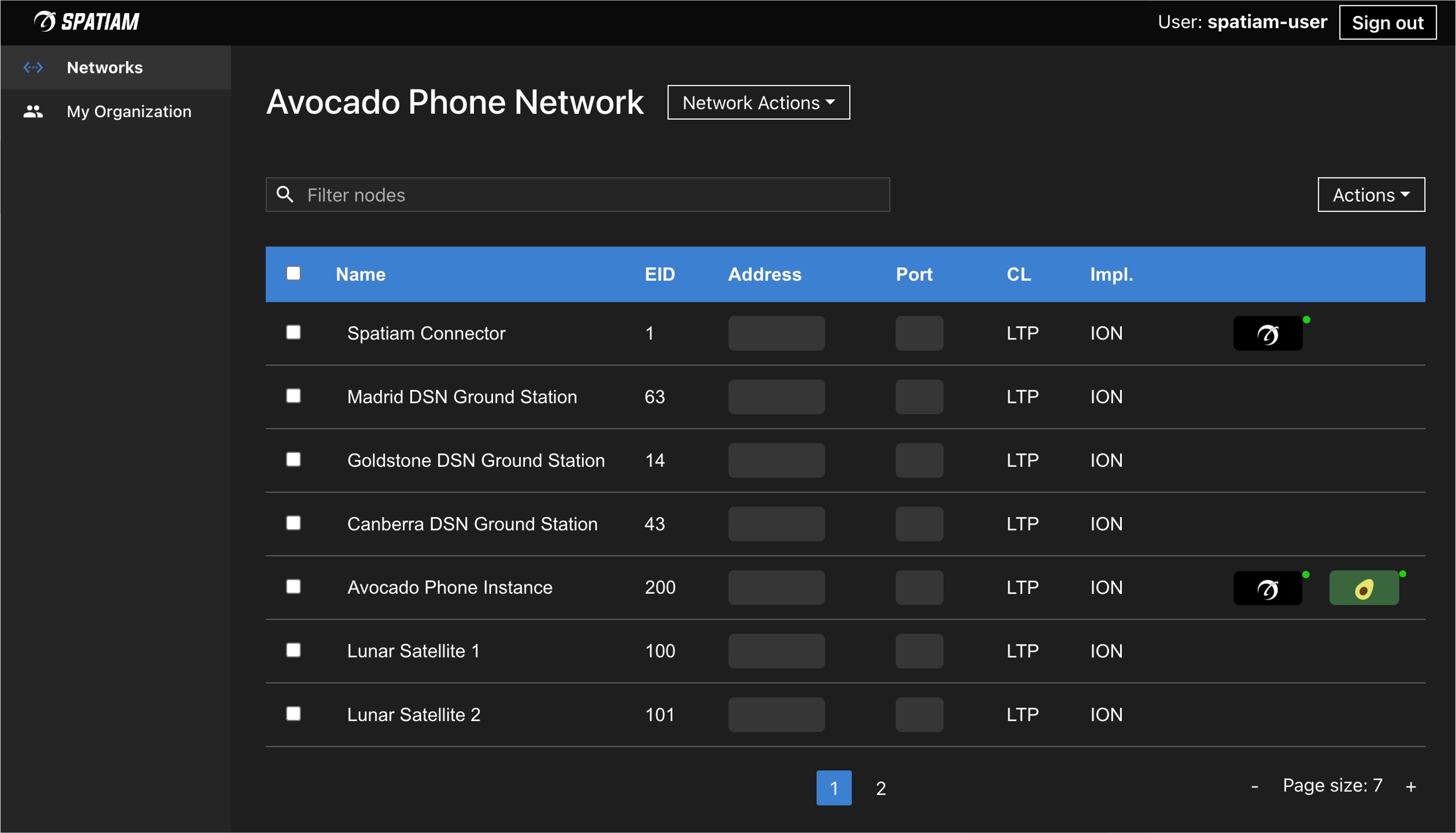
Resulting network in the Spatiam DTN Manager. Note the Avocado icon, indicating the node contains a phone client which can be accessed from the platform.
Ansys STK, a system for digital mission engineering and systems analysis was used to model the network's space assets to compute contacts between the DSN stations and the satellites orbiting the moon.
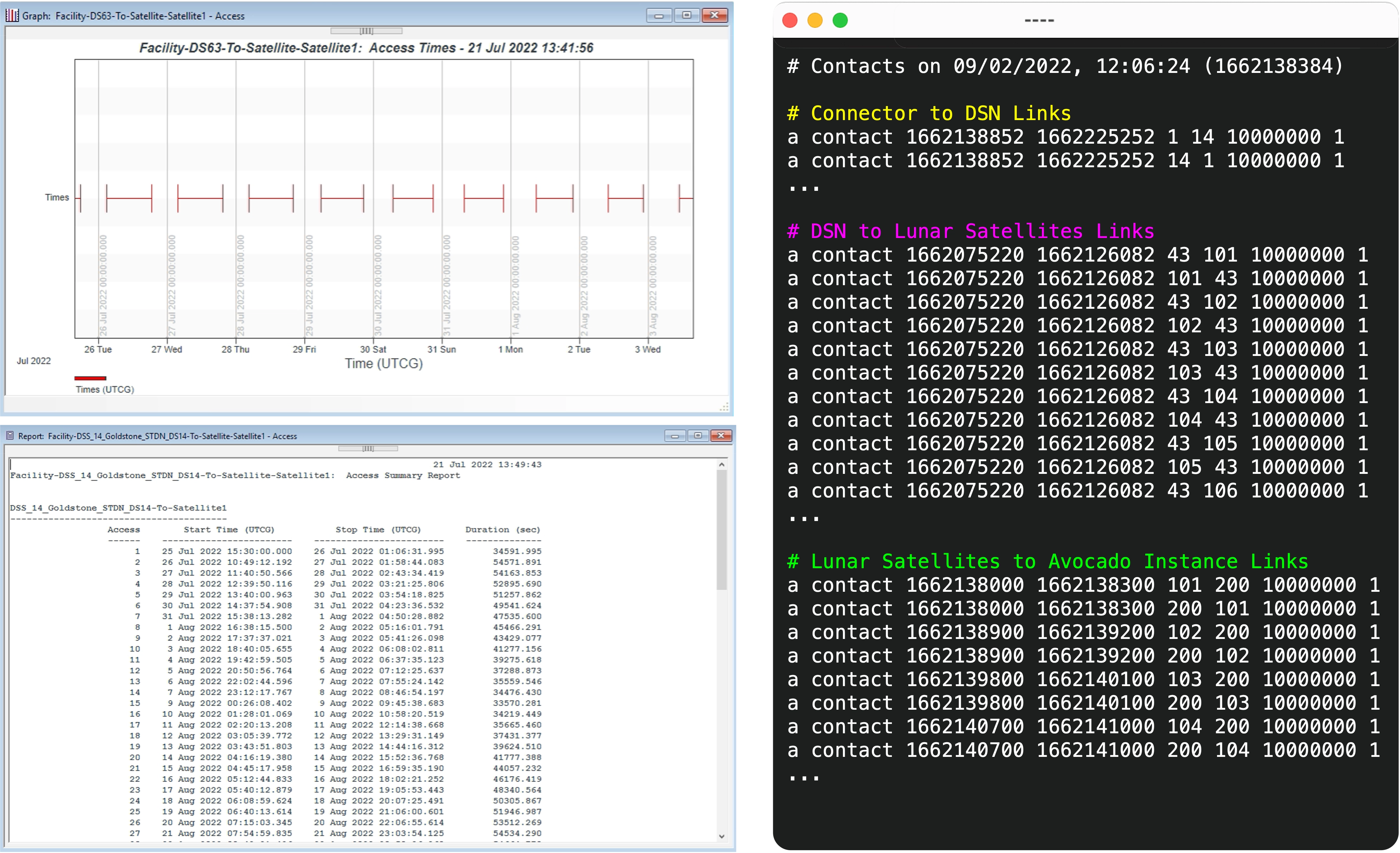
Contacts were created based on moon to DSN visibility, and then converted into contact plan readable formats.
Contact plans held information for 24 hours and re-generated by the Spatiam DTN Platform and delivered to the different instances every 12 hours, ensuring an always up to date and functional plan.
When messages are sent by a telephone user, the connector will receive the payload and forward it to the DSN station that has visibility to the satellite that is currently or soonest-to-be in contact with the Avocado Phone instance. If the satellite is in-contact with the Avocado Phone instance, the message will be received with a delay of a few seconds. If the satellite is not in-contact, it means that it will have a connection with the instance in at most 10 minutes (due to the 5-minute contact every 15 minutes). In either case, the connector will immediately reply to the sender of the message with the expected arrival time and expected delay of their message, as well as information about the path it will traverse to get to the final destination (specific DTN station and lunar satellite) based on the routing algorithm calculation (in this case Contact Graph Routing - CGR). Due to the nature of Delay and Disruption Tolerant Networking both the expected timing and path are subject to change because of various factors (network overload, malfunctions, unexpected disruption), however providing this information based on routing calculation is still valuable as users are informed of the expected delay of their message and can estimate a response from the final destination.
The video below shows a compilation of the two ends of the network during an in-contact time frame where delays are of a few seconds. Note that the second message begins with “Echo”, a testing functionality that prompts the Avocado Phone instance to automatically reply back when an echo message is received.
(Video) Avocado Phone in action.
Out-of-contact operations work in a similar fashion, where the reported time varies depending on when the next contact will occur. Our tests resulted in successful communications both in-contact and out-of-contact, receiving messages at the expected times.
Key Learnings
Creating an end-to-end application that relies on DTN requires several moving parts. Our biggest learning from this project came from understanding the elements required to make a functional network. First, a method to create and maintain contact plans was key, where the Spatiam DTN Platform became the central broker of this task. Our test DTN network was formed by 13 nodes, and while it may not seem like a large number of nodes, the considerable number of contacts increased the time taken to compute preferred bundle routes, making it impractical to load long-duration contact plans (e.g., a week or a month). The proposed 24-hour contact plan of the network contained roughly 123 bi-directional contacts (246 contact plan entries) per 24-hour period:
- 3 continuous contacts from connector to DSN stations.
- 8 contacts to lunar satellites (one per satellite) every time a new DSN antenna has visibility. On average the DSN station with moon visibility changes every 8 hours, there are 24 such contacts per day.
- 4 contacts per hour from lunar satellite to avocado phone instance (one every 15 minutes), 96 per day.
Contact Graph Routing (CGR) is the algorithm used to compute available routes, and we recorded that route calculation added a significant delay for larger contact plans.
Next, supporting data of various formats (voice, images, text) requires various delivery methods, or one that can adapt to the application's needs. We chose to use CFDP (CCSDS File Delivery Protocol) in our prototype to transfer all data as files and encode what type of data it corresponded to in the file itself.
Lastly, we developed several iterations of the Avocado Phone user experience. Delayed communications pose not only a challenge in data delivery but also in the way users interact with an application. At first, the user was simply told how long their message would take to reach the destination, and while that is the most important piece of information, giving the user more elements (expected arrival time, and message path), made it easier to set expectations and battle the fear of a message being stuck somewhere. This starting point provided findings that can be used to give the user more information and features to ensure they are aware of any network changes and that their messages will be received as expected.
Avocado Phone proves that large networks such as the Telephone Network can be connected to space with DTN technologies, and that regardless of the delays and disruptions along the way, we can provide reliable communications with a great user-experience.
This article was shared via The Bundle, Spatiam's quarterly newsletter.
